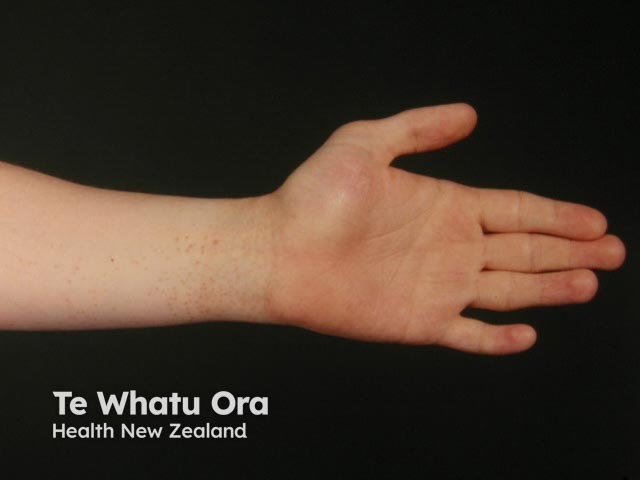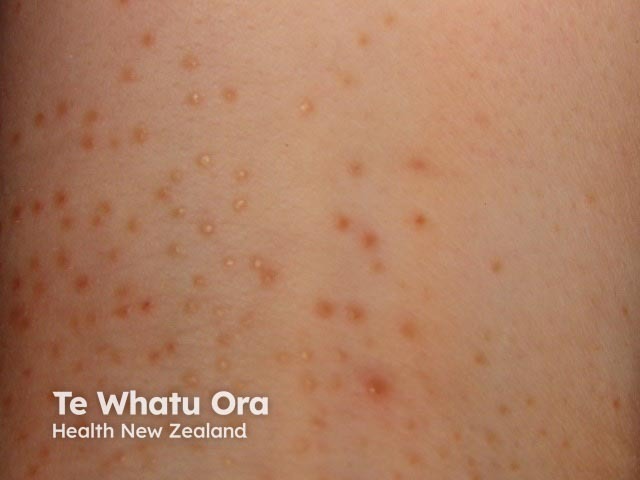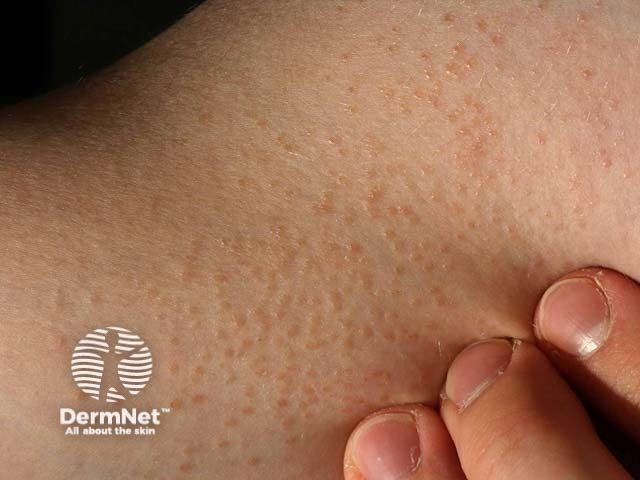Main menu
Common skin conditions

NEWS
Join DermNet PRO
Read more
Quick links
Lichen nitidus — extra information
Introduction
Demographics
Clinical features
Diagnosis
Treatment
What is lichen nitidus?
Lichen nitidus is an uncommon inflammatory skin condition that usually presents with tiny skin-coloured bumps in children. Although it has been considered a variant of lichen planus, lichen nitidus is now believed to be a separate and distinct entity.

Lichen nitidus

Lichen nitidus

Lichen nitidus
Who gets lichen nitidus and why?
Lichen nitidus usually begins in childhood, particularly preschool and school-aged children, or in young adult life. It affects both sexes equally and occurs in all races.
The cause of lichen nitidus is unknown.
Lichen nitidus has been reported in association with:
- Lichen planus
- Crohn disease
- Down syndrome
- Atopic dermatitis
- HIV infection
- Juvenile chronic arthritis
- Congenital megacolon
It is sometimes familial.
Clinical features of lichen nitidus
Typically lichen nitidus presents as a localised bumpy skin eruption involving the flexor aspects of the forearms, backs of hands, the penis, chest, abdomen and buttocks, although any site can be involved including the face.
The papules (bumps) have the following characteristics:
- Pinpoint to pinhead size – 1-2mm diameter
- Round or polygonal shape
- Skin coloured, less commonly yellow, red-brown or violet
- Hypo- or hyperpigmented in dark skinned patients
- Flat-topped
- Shiny
- Scaly
- Rarely, tiny blisters (vesicles)
- Rarely, a central depression (umbilication)
- Clustered in groups, which can become confluent to form plaques
- Often found over elbows and knees so they may resemble psoriasis
- Localised or rarely generalised
- Usually asymptomatic but they can be itchy.
The Köbner or isomorphic phenomenon is common, appearing as lichen nitidus papules arranged in a line along scratch mark sites.
The palms and soles may be affected. This may be unilateral or bilateral, localised or in combination with lesions in more typical sites. Lichen nitidus confined to the palms seems to affect an older age group (age range 37-52 years) and tends to be very persistent.
Lichen nitidus can involve the lining of the mouth, perhaps more commonly than is reported. The clinical features in this location are:
- Tiny grey-white flat papules inside the cheeks (buccal mucosa)
- White plaques on the tongue and hard palate
- May resemble oral lichen planus
Changes in the nails are seen in approximately 10%, particularly in adults. These may include:
- Pitting
- Longitudinal linear ridging
- Splitting of the free nail edge
- Rippling
- Redness of the proximal nailfold
Reported clinical variants of lichen nitidus include:
- Generalised lichen nitidus
- Haemorrhagic/purpuric lichen nitidus: the generalised purpuric form begins on tops of feet and around the ankles before progressing up the legs and becoming generalised over months. A palmar purpuric form may show accentuation at sites of mechanical stress
- Vesicular (blistering) lichen nitidus affects the palms and resembles pompholyx
- Actinic lichen nitidus appears on sun-exposed sites usually in dark-skinned patients and tends to be seasonal, recurring in summer
- Linear lichen nitidus – papules arise in a line
- A keratoderma form of lichen nitidus affects palms and soles, resembling chronic eczema with fissuring
- Perforating lichen nitidus is mostly reported on hands and forearms; it has umbilicated papules
How is lichen nitidus diagnosed?
Although the clinical presentation will suggest the diagnosis, lichen nitidus usually requires a skin biopsy to be confirmed. The histology of lichen nitidus is very typical and described as the ‘claw and ball’ appearance:
- Focal dense lymphohistiocytic infiltrate in the upper dermis very close to the epidermis.
- Langhans giant cells are often present in the infiltrate.
- Rete ridges of the epidermis are elongated and ‘clutch’ the infiltrate.
- Red blood cells are seen just under the epidermis in the haemorrhagic/purpuric form.
- Eosinophilic dermal material with some cell nuclei may be seen within the epidermis in the perforating variant.
Treatment of lichen nitidus
Usually no treatment is required, as lichen nitidus does not usually cause any symptoms and resolves within 12 months in two-thirds of cases. Post-inflammatory hyperpigmentation can persist for months, or in some cases, for years.
Treatment may be requested by patients with:
- Itch
- Generalised rash
- Involvement of cosmetically sensitive sites
- Prolonged course.
Treatments reported to have given some relief and/or resolution include:
- Light: including sunlight, narrowband UVB phototherapy, and photochemotherapy (PUVA)
- Topical corticosteroids
- Topical calcineurin inhibitors (tacrolimus and pimecrolimus)
- Contact sensitisation with DNCB or diphencyprone
In severe cases, systemic treatments may be considered, including:
- Corticosteroids
- Ciclosporin
- Retinoids – acitretin
- Astemizole (antihistamine, a selective H1 antagonist)
- Itraconazole
- Isoniazid (antibiotic often used to treat tuberculosis).
References
- Arrue I, Arregui MA, Saracibar N, Soloeta R. Perforating lichen nitidus on an atypical site. Actas Dermosifiliogr. 2009; 100: 429–36. Journal
- Bolognia JL, Jorizzo JL, Rapini RP. Dermatology (first edition)
- Burns T, Breathnach S, Cox N, Griffiths C. Rook’s Textbook of Dermatology (7th edition)
- Do M-O, Kim M-J, Kim S-H, Myung K-B, Choi Y-W. Generalized lichen nitidus successfully treated with narrow-band UVB phototherapy : Two cases report. J Korean Med Sci 2007; 22: 163–6. Journal
- Ikenberg K, Pflugfelder A, Metzler G, Biedermann T. Thirty-year history of palmar eruptions: A quiz. Acta Derm Venereol 2011; 91: 108–9. Journal
- Park SH, Kim SW, Noh TW, Hong KC, Seok Kang SY, Lee UH, Park HS, Jang SJ. A case of palmar lichen nitidus presenting as a clinical feature of pompholyx. Ann Dermatol 2010; 22: 235–7. PubMed Central
- Rallis E, Verros C, Moussatou V, Sambaziotis D, Papadakis P. Generalized purpuric lichen nitidus. Report of a case and review of the literature. Dermatol Online J 2007; 13(2):5. Journal
- Summey BT, Cusack CA. Actinic lichen nitidus. Cutis 2008; 81: 266–8. PubMed Central
- Tilly JJ, Drolet BA, Esterly NB. Lichenoid eruptions in children. J Am Acad Dermatol. 2004; 51: 606–24. PubMed
On DermNet
Other websites
- Lichen Nitidus — Medscape Reference
- Lichen Nitidus — Therapeutics in Dermatology, Fondation René Touraine
